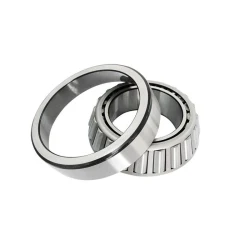Key Features of Tapered Roller Bearings
2024-05-17
Tapered roller bearings are a type of rolling-element bearing designed to handle large radial and axial forces. They consist of four main components: the inner ring (cone), the outer ring (cup), tapered rollers, and the cage (retainer). The unique feature of these bearings is the tapered shape of the rollers and the raceways, which allows them to support both radial and axial loads simultaneously.
Key Features
1. Design: The inner and outer ring raceways are segments of cones, and the rollers are also tapered. This design allows the bearings to handle a combination of radial and axial loads.
2. Load Distribution: Tapered roller bearings can support high loads due to the larger contact area between the rollers and the raceways. The contact angle, which is the angle between the line of contact between the roller and raceway and the bearing axis, determines the ratio of axial to radial load capacity.
3. Applications: These bearings are commonly used in automotive wheel hubs, gearboxes, and other applications requiring high load capacity and precision. They are essential in many industrial machines, construction equipment, and heavy-duty vehicles.
Types and Variations
- Single-Row Tapered Roller Bearings: These are the most common type and can support axial loads in one direction. They are typically used in pairs to handle axial loads in both directions.
- Double-Row Tapered Roller Bearings: These bearings can support axial loads in both directions and are often used in gearboxes and other applications where space is a constraint.
- Four-Row Tapered Roller Bearings: Used in heavy machinery, such as rolling mills, where they can handle high radial and axial loads.
Installation and Maintenance
1. Preloading: Proper preloading is essential for optimal performance. Preloading involves applying a certain amount of axial force to eliminate internal clearances, improving the rigidity and lifespan of the bearing.
2. Lubrication: Adequate lubrication is crucial for reducing friction and wear. Grease or oil lubrication is typically used depending on the application requirements.
3. Alignment: Correct alignment of the bearing components is necessary to avoid uneven load distribution and premature wear.
Advantages
- High Load Capacity: Due to the larger contact area and robust design.
- Durability: Designed to withstand heavy loads and harsh operating conditions.
- Versatility: Can handle both radial and axial loads.
Disadvantages
- Complex Assembly: Requires precise installation and alignment.
- Higher Friction: Compared to other types of bearings like ball bearings, tapered roller bearings may have higher friction.
Selection Criteria
When selecting a tapered roller bearing, consider factors such as load capacity, speed, operating environment, and the specific application's requirements. Proper selection ensures optimal performance and longevity of the bearing.
In summary, tapered roller bearings are a versatile and robust bearing solution for applications requiring the ability to handle combined radial and axial loads. Their design and performance characteristics make them suitable for a wide range of industrial and automotive applications.



